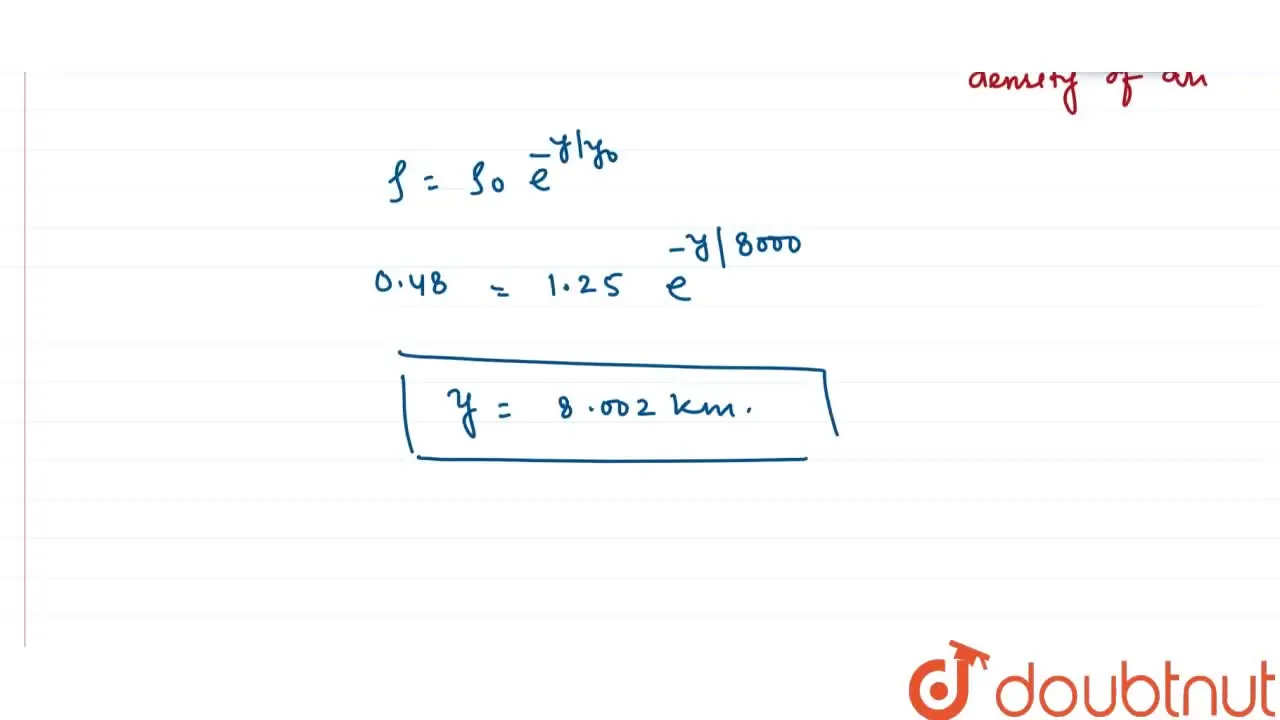(a). It is known that density ρ of air decreases with height y as
ρ=ρ0e−y/y(_o) ltb rgt where po=1.25kgm−3 is the density at sea level, and yo is a constant. This density variation is called the law of atmospheres. Obtain this law assuming that the temperature of atmosphere remains a constant (isothermal conditions). Also assume that the value of g remains constant
(b). A large He balloon of volume 1425m3 is used to lift a payload of 400 kg. Assume that the balloon maintains constant radius as it rises. How high does it rise?
[take yo=8000mandρHe=0.18kgm−3]
(a). We know that rate of decrease of density p of air is directly proportional to the height y. it is given as dρ/dy=−ρ/y0
where y is constant of proportionally and -ve sign signifies that density is decreasing with increase in height. On integration, we get
ρ∫ρ0dρρ=−∫y01y0dy
⇒[logρ]ρρ0=−[yy0]y0, where ρ0= density of air at sea level i.e., y=0
or log2(ρ)ρ0=−yy0 or ρ=ρ0e−yy0
here dimensions and units of constant y0 are same as of y.
(b). Here volume of He balloon, V=1425m3, mass of payload, m=400kg
y0=8000m, density of He ρHe=0.18kgm−3
Mean density of balloon ρ=Total mass of balloonVolume=m+V⋅ρHeVPa
=400+1425×0.181425=0.4608=0.46kgm−3
As density of air at sea level ρ0=1.25kgm−3 the balloon will rise up to a height y
where density of air =density of balloon ρ=0.46kgm−3
As ρ=ρ0e−yy0 or ρ0ρ=ey0y
∴loge(ρ0ρ)=y0y or y=y0loge(ρ0ρ)=8000loge(1.250.46)
=8002m or 8.0km
Related Playlists
- BOOK - NCERT ENGLISHCHAPTER - MECHANICAL PROPERTIES OF FLUIDSEXERCISE - EXERCISE31videos
MECHANICAL PROPERTIES OF FLUIDS
- BOOK - NCERT ENGLISHCHAPTER - LAWS OF MOTION EXERCISE - EXERCISE40videos
LAWS OF MOTION
- BOOK - NCERT ENGLISHCHAPTER - MECHANICAL PROPERTIES OF SOLIDSEXERCISE - EXERCISE21videos
MECHANICAL PROPERTIES OF SOLIDS
Similar Questions
If P is the pressure and ρ is the density of a gas, then P and ρ are related as :
View SolutionWhich of the following is a graph of the relation of the density (ρ) of a gas sample to the absolute tempeature keeping constant pressure.
View SolutionThe mean density of sea water is ρ, and bulk modulus is B. The change in density of sea water in going from the surface of water to a depth of h is
View SolutionCalculate height (Approx) of atmosphere considering density of atmosphere is uniform (ρ=1.3kg/m3)
View SolutionFor a ideal monoatomic gas match the following graphs for constant mass in different processes (ρ = Density of gas)
_E01_156_Q01.png) View Solution
View SolutionThe density of the given gas at constant pressure and temperature is ρ and its rate of diffusion isr. If density of the gas becone ρ/3 then rate of diffusion becomes
View SolutionThe pressure at depth h below the surface of a liquid of density ρ open to the atmosphere is
View SolutionThe acceleration due to gravity g and density of the earth ρ are related by which of the following relations? (where G is the gravitational constant and RE is the radius of the earth)
View SolutionThe density of the atmosphere at sea level is 1.29kg/m3. Assume that it does not change with altitude, how high should the atmosphere extend?
View SolutionThe density of a metal at normal pressure is ρ. Its density when it is subjected to an excess pressure p is ρ' . If B is the bluk modulus of the metal, then find the ratio ρ'/ρ.
View Solution


